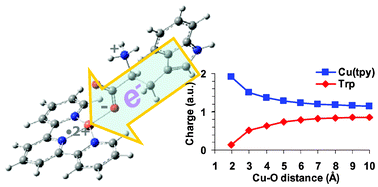The dissociations of two types of copper(II)-containing complexes of tryptophan (Trp), tyrosine (Tyr), or phenylalanine (Phe) are described. The first type is the bis-amino acid complex, [CuII(M)2]˙2+, where M = Trp, Tyr, or Phe; the second [CuII(4Cl-tpy)(M)]˙2+, where 4Cl-tpy is the tridendate ligand 4′-chloro-2,2′:6′,2″-terpyridine. Dissociations of the Cu(II) bis-amino acid complexes produce abundant radical cation of the amino acid, M˙+, and/or its secondary products. By contrast, dissociations of the 4Cl-tpy-bearing ternary complexes give abundant M˙+ only for Trp. Density functional theory (DFT) calculations show that for Tyr and Phe, amino-acid displacement reactions by H2O and CH3OH (giving [CuII(4Cl-tpy)(H2O)]˙2+ and [CuII(4Cl-tpy)(CH3OH)]˙2+) are energetically more favorable than dissociative electron transfer (giving M˙+ and [CuI(4Cl-tpy)]+). The fragmentation pathway common to all these [CuII(4Cl-tpy)(M)]˙2+ ions is the loss of NH3. DFT calculations show that the loss of NH3 proceeds via a “phenonium-type” intermediate. Dissociative electron transfer in [CuII(4Cl-tpy)(M–NH3)]˙2+ results in [M–NH3]˙+. The [Phe–NH3]˙+ ion dissociates facilely by eliminating CO2 and giving a metastable phenonium-type ion that rearranges readily into the styrene radical cation.

You have access to this article
 Please wait while we load your content...
Something went wrong. Try again?
Please wait while we load your content...
Something went wrong. Try again?


 Please wait while we load your content...
Please wait while we load your content...